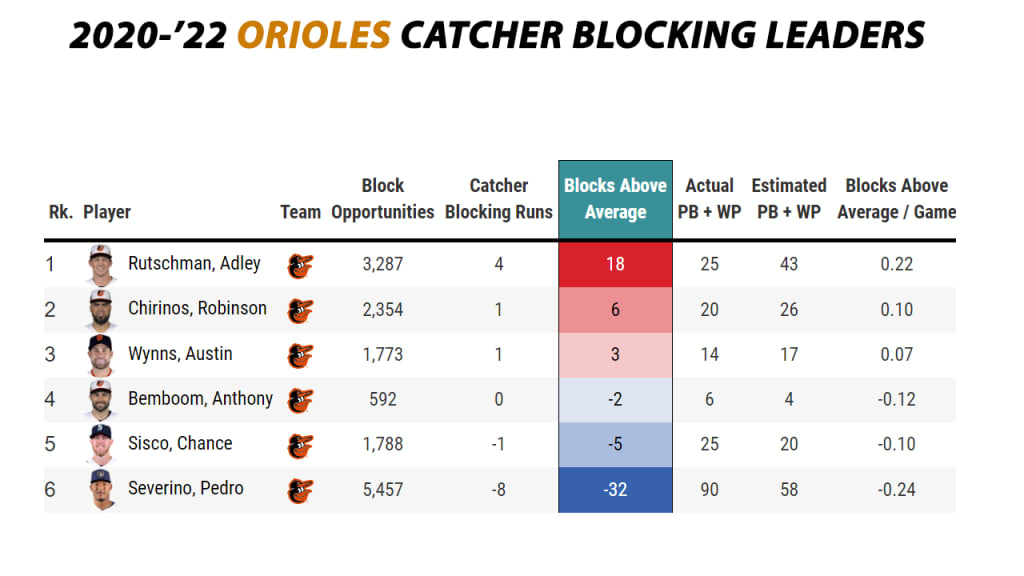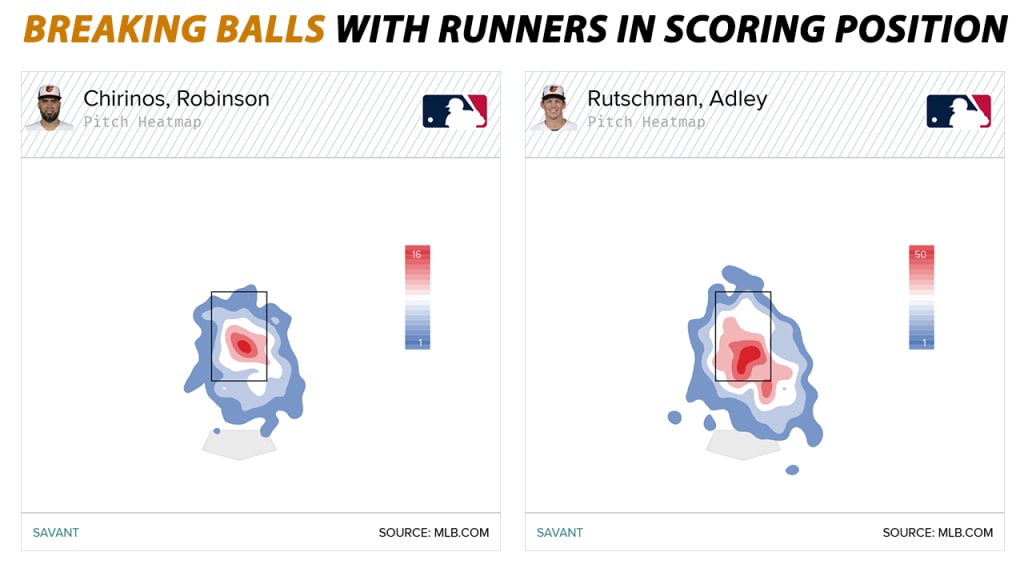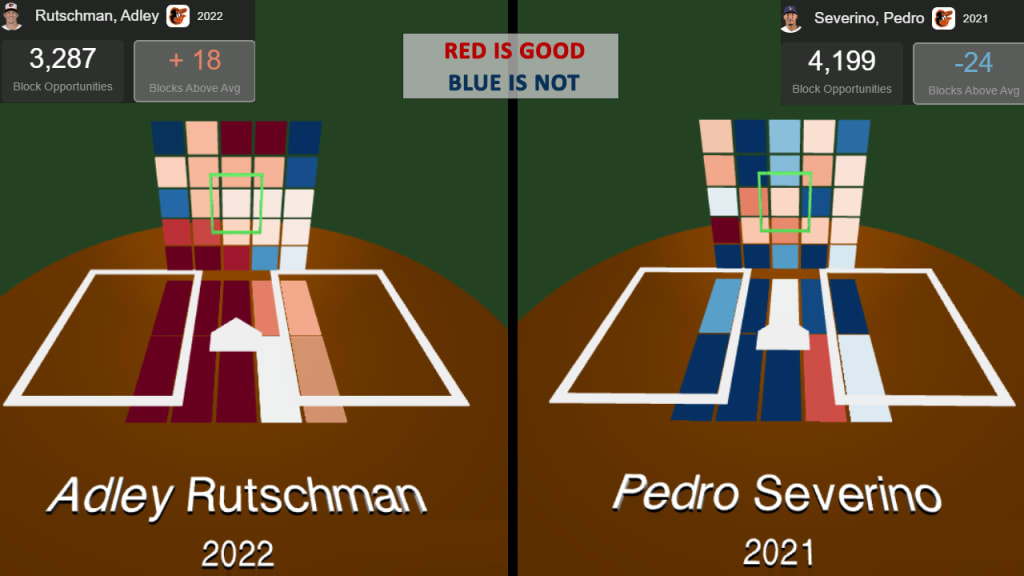It’s a little too much to say that the lost years in Baltimore of 2017-21 ended the day that Adley Rutschman was called up to Majors last May, but since it’s a lot easier to see the immediate impact of a No. 1 overall Draft pick than it is to notice years of behind the scenes work from a front office that reinforced the foundations of the franchise, we’ll go with it.
On the day Rutschman arrived, the Orioles were 16-24, last in the AL East, headed for their fifth straight full-season last-place finish. For the remainder of the season, they were 67-55 (an 89-win pace) and largely in the playoff hunt. If you skip past Rutschman’s rough first two weeks and point to June 11 as the day he figured it all out, he was then second only to Aaron Judge in wins above replacement through the end of the season. It wasn't all him, but it wasn't not him, either.
You probably know why. Rutschman’s bat was as advertised, posting a 128 OPS+ as a rookie and being a Top-20 hitter from that June 11 date on. Behind the plate, his framing was strong, representing a massive improvement (+4 runs by Statcast’s measurements) over not only teammate's Robinson Chirinos’s weak 2022 performance (-14 runs), but also former Orioles Pedro Severino and Austin Wynns combining to be 2021’s weakest framing team (-17 runs).
He was, by all indications, outstanding. But what we didn’t talk about, not enough, was something that became evident in the very first inning of his very first game. After getting the first out, Orioles starter Kyle Bradish got ahead of Yandy Diaz 0-2, then buried a slider that landed in the opposite batter's box. Diaz went after it. Rutschman got in front of it. Strikeout, saved.
Sometimes, we think so much about the other things catchers are expected to do -- like throwing out baserunners, and framing pitches, and calling a game -- that we forget to talk about the term that gives the position its name. You know, catching. Which is another thing that Rutschman is good at -- the best, actually according to the newest Statcast metric, Blocks Above Average, which is now available on Baseball Savant dating back to 2020.
Look at the 2022 leaderboard. There Rutschman is, just ahead of a few other catchers widely perceived to be some of the best backstops in the game.

We’ll explain how this works further and get into those other catchers in a follow-up piece. For Rutschman, the short version is this: Based on the opportunities he was presented with, an average catcher would have been expected to allow 43 passed balls or wild pitches, the third-most of any catcher. (More on that, and the staff he had to catch, below.)
Yet Rutschman allowed a mere 25, not 43. The difference of +18 is what you see on the leaderboard. Compare that to Colorado's Elías Díaz, who also saw pitches that would have been estimated to become 43 passed balls or wild pitches. He allowed 42, or +1. It's a big gap.
Chirinos, to be fair, was solid enough at this part of the game, earning +6 Blocks Above Average. But if you really want to see the value that Rutschman brought here, just look at the difference over the last three years in this skill from the six semi-regular Orioles backstops.

Wynns, Anthony Bemboom and Chance Sisco were various flavors of adequate. Chirinos was good. But Severino, who was outrighted following 2021 and caught just four times for Milwaukee in 2022, actually rates 122nd of 122 qualified catchers over the last three years. It's quite literally going from worst to best.
“[Rutschman] is really, really good,” pitcher Dean Kremer told the Baltimore Sun in August. “It’s not just his framing ability. It’s his ability to block, so when we’ve got guys in scoring position, I’m not worried about guys advancing.”
Exactly, and we can see this in action, just like Kremer said. Look at where Orioles pitches threw their breaking balls with runners in scoring position to Rutschman as compared to Chirinos. Again, it’s not quite like Chirinos was poor at this, but the difference between “middle of the zone” and “bottom or below the zone” is quite noticeable.

We’d make a bigger deal out of the fact that on Rutschman’s pitches here, he caught a 28% strikeout rate, while Chirinos had just a 19% rate, though that probably requires going a little deeper into who exactly was throwing and facing those pitches than we’re prepared to do right now.
Still, it matches both the eye test and the numbers. These blocking metrics are based on putting a difficulty number on each opportunity -- based mostly on pitch location, pitch speed, pitch movement, catcher location, and batter/pitcher handedness, while considering only pitches where a passed ball or wild pitch is even possible, so excluding balls in play, fouls, bases empty pitches and so on -- and by capturing that number on each pitch, noting the success or failure rate and adding them up, you can get to a season-long number.
So for example, here’s a pitch Rutschman receives just about no credit for, because it’s a chance that’s caught very nearly 100% of the time. We won’t even embed it. It’s not that interesting to watch. (There’s so many of these. Inside the strike zone last year, only 36 of nearly 200,000 blockable pitches were wild pitches or passed balls, or functionally zero.)
But here is a pitch that is a block just under 40% of the time. Rutschman gets a great deal of credit for this one.
You can see exactly where, too. When the ball hits the dirt in front of him, Rutschman is outstanding. (We’ll show Severino’s 2021 as a comparison point. Here's a video of him failing to catch a third strike, if you'd like to see it.) Look at all that beautiful, beautiful red.

That’s important, because in the situations that matter, the 2022 Orioles were the most difficult pitching staff in the Majors to catch. Only four teams threw more pitches to the non-competitive area far above the strike zone, and among those pitches, Baltimore’s were higher than anyone’s. Flip it around to find the buried pitches far below the zone, and Baltimore’s pitches way down low were the lowest.
If we take the block probability of each pitch and say that every pitch with less than an 85% expectation of being blocked is “tough,” well, the 2022 Orioles pitchers threw the most tough-to-block pitches, just ahead of the Rockies and Yankees -- and the extremely different levels of productivity from those staffs should tell you there’s more than one way to throw pitches that are hard for catchers to receive.
If you want to see what those "tough" chances look like, let's share a few. This is the kind of pitch that almost always sails to the backstop; Rutschman saves Bryan Baker a base, at least.
Here’s a pitch that is more difficult than it looks, keeping a runner at first base.
This only ever so slightly qualifies as “tough” for us, but it looked so nice we had to include it.
Only four teams threw their breaking balls with more spin; only six used more different pitchers. Those don’t even go into these calculations, but you get the idea. The 2022 O’s were a tough job for a rookie catcher. Just look at what he was faced with, and remember that these are just the block opportunities, not all the pitches he saw.
Maybe this shouldn't come as a surprise, because Rutschman wasn’t just born to be a ballplayer, he was born to be a catcher, given that his father, Randy, has been a college catching coach for decades. (At 8 years old, Randy had Adley featured in a DVD of catching drills for young players. It doesn’t stop there. Adley’s grandfather, Ad, was once drafted by the NFL’s Detroit Lions and as of 2021, was the only coach to win college titles in both baseball and football.) It's showing, even this early in his career. He might already be baseball's best all-around backstop. This is just further evidence of that. The Orioles were worst at this in 2020. They were second-worst in 2021. They were second best in 2022.
And stay tuned: We’ll have a follow-up shortly that goes into further depth on the metric and who else appears to be good or bad at this particular skill.
Further reading
It’s no hyperbole to say that writers and analysts have been thinking about this for years, so while this new tool has features and visuals you’ve never seen before, this is building on decades of previous thought and work, all worth reviewing. Tom Tango, MLB’s Senior Data Architect and the creator of this model, has been writing about it since at least 2003, publishing another study in 2008. There have been seminal looks at this by Beyond the Box Score in 2008, and The Baseball Analysts in 2009, The Hardball Times in 2011, among many others, and more recently FanGraphs, Baseball Prospectus, and Sports Info Solutions have hosted their own versions of the concept.
You can find the daily-updated Baseball Savant leaderboard, splits, and visuals here.
